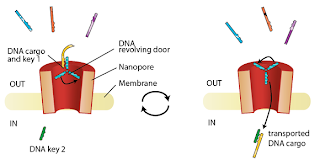A living cell is built with barriers to keep things out – and researchers are constantly trying to find ways to smuggle molecules in. Professor Giovanni Maglia (Biochemistry, Molecular and Structural Biology, KU Leuven) and his team have engineered a biological nanopore that acts as a selective revolving door through a cell's lipid membrane. The nanopore could potentially be used in gene therapy and targeted drug delivery.
All living cells are enclosed by a lipid membrane that separates the interior of the cell from the outside environment. The influx of molecules through the cell membrane is tightly regulated by membrane proteins that act as specific doorways for the trafficking of ions and nutrients. Membrane proteins can also be used by cells as weapons. Such proteins attack a cell by making holes – nanopores – in 'enemy' cell membranes. Ions and molecules leak from the holes, eventually causing cell death.
Researchers are now trying to use nanopores to smuggle DNA or proteins across membranes. Once inside a cell, the DNA molecule could re-programme the cell for a particular action. Professor Maglia explains: "We are now able to engineer biological nanopores, but the difficult part is to precisely control the passage of molecules through the nanopores' doorways. We do not want the nanopore to let everything in. Rather, we want to limit entry to specific genetic information in specific cells."
Professor Maglia and his team succeeded in engineering a nanopore that works like a revolving door for DNA molecules. "We have introduced a selective DNA revolving door atop of the nanopore. Specific DNA keys in solution hybridise to the DNA door and are transported across the nanopore. A second DNA key on the other side of the nanopore then releases the desired genetic information. A new cycle can then begin with another piece of DNA – as long as it has the correct key. In this way, the nanopore acts simultaneously as a filter and a conveyor belt."
"In other words, we have engineered a selective transport system that can be used in the future to deliver medication into the cell. This could be of particular use in gene therapy, which involves introducing genetic material into degenerated cells in order to disable or re-programme them. It could also be used in targeted drug delivery, which involves administering medication directly into the cell. The possibilities are promising."
The researchers' findings were published in a recent edition of Nature Communications.


No comments:
Post a Comment